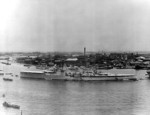Walrus
| Country | United Kingdom |
| Manufacturer | Supermarine Aviation Works |
| Primary Role | Seaplane |
| Maiden Flight | 1 January 1935 |
Contributor: C. Peter Chen
ww2dbaseThe Walrus amphibious reconnaissance aircraft were designed by R. J. Mitchell of Supermarine Aviation Works. They were meant to be launched from ship-borne catapults, and they were the first such amphibious aircraft in the world while carrying a full military load. In 1935, Walrus aircraft entered service with the Royal Australian Air Force under the Seagull V A2 designation. On 16 Mar 1936, they entered service with the British Royal Air Force. In the same year, the New Zealand division of the British Royal Navy also received them. By the time the European War began, they were in widespread use. During the war, they were credited with sinking or damaging at least five German submarines and rescuing many downed airmen. The Irish Air Corps used them during the Irish Emergency period during WW2 for maritime patrol. After the war, one Walrus aircraft, HD874, participated with the Australian Antarctic Expedition in 1947.
ww2dbaseA total of 740 Walrus aircraft were built. They were built in three major variants. The original metal hull variant was designated Seagull V, the second metal hull variant was designated Walrus I, and the wooden hull variant was designated Walrus II. Some of the nicknames for the aircraft include "Shagbat" and "Steam Pigeon".
ww2dbaseSource: Wikipedia.
Last Major Revision: Jun 2008
SPECIFICATIONS
Walrus
| Machinery | One Bristol Pegasus VI radial engine rated at 680hp |
| Armament | 2x7.7mm Vickers K machine guns, 345kg of bombs or depth charges |
| Crew | 3 |
| Span | 14.00 m |
| Length | 11.45 m |
| Height | 4.60 m |
| Wing Area | 56.70 m² |
| Weight, Empty | 2,220 kg |
| Weight, Loaded | 3,265 kg |
| Speed, Maximum | 215 km/h |
| Rate of Climb | 5.30 m/s |
| Service Ceiling | 5,600 m |
| Range, Normal | 965 km |
Photographs
 |  |  |  |
Você gostou deste artigo ou achou este artigo útil? Se sim, considere nos apoiar no Patreon. Qualquer valor já vai ajudar! Obrigado. Por favor, ajude-nos a divulgar o site: Fique atualizado com WW2DB: |
Visitor Submitted Comments
All visitor submitted comments are opinions of those making the submissions and do not reflect views of WW2DB.

- » The Emperor of Japan Planned to Honor WW2-era Japanese POWs in Mongolia (4 Jul 2025)
- » US State Lawmaker John Winter Caught Using Racial Slur "Jap" and Apologized (11 Jun 2025)
- » Köln/Cologne Evacuated After Discovery of WW2 Bombs (4 Jun 2025)
- » Race, Holocaust, and African-American WW2 Histories Removed from the US Naval Academy Library (7 Apr 2025)
- » US Government Plans to Purge WW2 Information (17 Mar 2025)
- » Ver todas as notícias
- » 1,178 biografias
- » 337 eventos
- » 45,089 entradas na linha do tempo
- » 1,245 navios
- » 350 modelos de aeronaves
- » 207 modelos de veículos
- » 376 modelos de armas
- » 123 documentos históricos
- » 261 instalações
- » 470 eventos
- » 28,481 fotos
- » 365 mapas
James Forrestal, Secretary of the Navy, 23 Feb 1945
Por favor, considere nos apoiar no Patreon. Mesmo R$1 por mês já faz uma grande diferença. Obrigado!
Ou, por favor, nos apoie adquirindo alguns produtos do WW2DB na TeeSpring. Obrigado!
10 Mar 2017 09:57:10 AM
thank u for a look into british ww2 history.